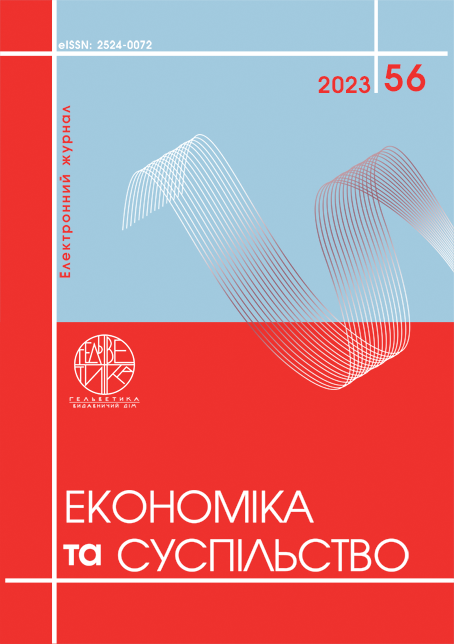UNIVERSITIES' RATING: ASSESSMENT AND CONSEQUENCES
Abstract
The study purpose is a critical analysis modern university rating methods, systematization rating criteria taking into account the interests of all stakeholders. Despite significant criticism in academic circles, the Times Higher Education, World University Rankings Quacquarelli Symonds and Shanghai Ranking Consultancy remain the most popular among the world's university rankings. The rating purpose is to create a basis for comparison and simplify decision-making by certain target groups - stakeholders of educational process. However, one gets the impression that the target group of the mentioned ratings is intentionally left undefined in order to create the appearance of the rating assessment universality. Analysis of rating criteria made it possible to establish common evaluation parameters: quality of education and teaching, bibliometric indicators. However, these criteria are not equally interesting to applicants and teachers, employers and universities. In addition, within the same target group, for example, universities, there are special input parameters (branch of knowledge, university’s size, access to financing, level of education affordability, etc.) that increase the priority of some and reduce the importance of other rating criteria. Despite the fact that for applicants, the rating and prestige of the university is an important criterion, for students who combine studies with work, or those who already have work experience, the importance of the education and teaching quality, employers’ reputation are increasing. ARWU Ranking and THE Rankings have a different ratio between "educational" and "research" indicators - 50:40 and 30:60, respectively, and in QS Rankings and U.S.News Best Global Universities Ranking indicators education and teaching quality are not distinguished at all. Therefore, criteria and their importance reflect the different significance of integrated rating for a separate target group. The university's rating should be the consequence of following development strategy in accordance with the mission, vision and values declared by the university, and not vice versa.
References
Hamann Ju., Ringel L. The discursive resilience of university rankings. Retrieved from: https://doi.org/10.1007/s10734-022-00990-x
Academic Ranking of World Universities (ARWU). Retrieved from: https://www.shanghairanking.com/news/arwu.
Times Higher Education World University Rankings. Retrieved from: https://www.timeshighereducation.com/world-university-rankings.
QS World University Rankings. Retrieved from: https://www.topuniversities.com/qs-world-university-rankings.
U.S.News Best Global Universities Ranking. Retrieved from: https://www.usnews.com/education/best-global-universities/rankings.
Szluka P.Relationship between bibliometric indicators and university ranking positions. Retrieved from: https://www.nature.com/articles/s41598-023-35306-1.
Кривцун І.М. Сучасні підходи до оцінювання конкурентоспроможності у вищій освіті. Retrieved from: DOI: https://doi.org/10.32782/2524-0072/2023-50-72.
Brankovic J., Hamann J., Ringel L. The institutionalization of rankings in higher education: continuities, interdependencies, engagement. Retrieved from: https://doi.org/10.1007/s10734-023-01018-8.
Gerdin J., Englund H. Contesting commensuration public response tactics to performance evaluation of academia. Retrieved from: www.emeraldinsight.com/0951-3574.htm.
Lim М. The building of weak expertise: the work of global university rankers. Retrieved from: DOI 10.1007/s10734-017-0147-8.
Shahjahan, R. A., Grimm, A., & Allen, R. M. (2021). The “LOOMING DISASTER” for higher education: How commercial rankers use social media to amplify and foster affect. Higher Education. Retrieved from: https://doi.org/10.1007/s10734-021-00762-z.
Nomanesi Madikizela-Madiya. What Is the Mission of This University? Te Question of Isomorphism and Quality Practices in the Era of Institutional Rankings. Retrieved from: doi:10.1108/S2055-364120220000043009
Elken M., Hovdhaugen E., Stensaker B. Global rankings in the Nordic region: challenging the identify of research-intensive universities? Retrieved from: DOI 10.1007/s10734-015-9975-6
Lebherz Carmen, Mohr, Cordula, und an. (2005). Wie brauchbar sind Hochschul-Rankings? Eine empirische Analyse Teichler, Ulrich [Hrsg.]; Tippelt, Rudolf [Hrsg.]: Hochschullandschaft im Wandel. Weinheim u.a. : Beltz 2005, S. 188-208. - (Zeitschrift für Pädagogik, Beiheft; 50) .
Marcelo M., Justin J. W. Powell (2019) Ratings, rankings, research evaluation: how do Schools of Education behave strategically within stratified UK higher education? Retrieved from: https://doi.org/10.1007/s10734-019-00440-1.
Опитування студентів економічних спеціальностей НУЛП «Якісна Освіта - Успішне Майбутнє», 2021. URL: https://docs.google.com/forms/d/1yzJLDksYMAvWCmFNhcUb5rt-Hfw62cVlJsYXJx4qJTo/edit.
Hamann Ju., Ringel L. (2023) The discursive resilience of university rankings. https://doi.org/10.1007/s10734-022-00990-x.
Academic Ranking of World Universities (ARWU). Retrieved from: https://www.shanghairanking.com/news/arwu.
Times Higher Education World University Rankings (THE). Retrieved from: https://www.timeshighereducation.com/world-university-rankings.
QS World University Rankings (QS). Retrieved from: https://www.topuniversities.com/qs-world-university-rankings.
U.S.News Best Global Universities Ranking. Retrieved from:https: https://www.usnews.com/education/best-global-universities/rankings.
Szluka P. (2023) Relationship between bibliometric indicators and university ranking positions. https://www.nature.com/articles/s41598-023-35306-1.
Kryvtsun I. (2023). Suchasni pidkhody do otsiniuvannia konkurentospromozhnosti u vyshchii osviti. [Modern approaches to competitiveness assessment in higher education]. DOI: https://doi.org/10.32782/2524-0072/2023-50-72.(in Ukrainian).
Brankovic J., Hamann J., Ringel L. (2023). The institutionalization of rankings in higher education: continuities, interdependencies, engagement. https://doi.org/10.1007/s10734-023-01018-8.
Gerdin J., Englund H.(2019). Contesting commensuration public response tactics to performance evaluation of academia. https://www.emerald.com/insight/content/doi/10.1108/AAAJ-09-2016-2717/full/html.
Lim М. (2018)/ The building of weak expertise: the work of global university rankers. DOI 10.1007/s10734-017-0147-8.
Shahjahan, R. A., Grimm, A., & Allen, R. M. (2021). The “LOOMING DISASTER” for higher education: How commercial rankers use social media to amplify and foster affect. Higher Education. https://doi.org/10.1007/s10734-021-00762-z.
Nomanesi M.-M. (2022). What Is the Mission of This University? Te Question of Isomorphism and Quality Practices in the Era of Institutional Rankings. DOI:10.1108/S2055-364120220000043009/
Elken M., Hovdhaugen E., Stensaker B. (2016). Global rankings in the Nordic region: challenging the identify of research-intensive universities? DOI 10.1007/s10734-015-9975-6.
Lebherz Carmen, Mohr, Cordula, und an. (2005). Wie brauchbar sind Hochschul-Rankings? Eine empirische Analyse Teichler, Ulrich [Hrsg.]; Tippelt, Rudolf [Hrsg.]: Hochschullandschaft im Wandel. Weinheim u.a. : Beltz 2005, S. 188-208. - (Zeitschrift für Pädagogik, Beiheft; 50) .
Marcelo M., Justin J. W. Powell (2019). Ratings, rankings, research evaluation: how do Schools of Education behave strategically within stratified UK higher education? https://doi.org/10.1007/s10734-019-00440-1.
(2021) Opytuvannia studentiv ekonomichnykh spetsialnostei NULP «Iakisna Osvita - Uspishne Maibutnie» [Survey of economics students National University Lviv Polytechnic "Quality Education - Successful Future"]. https://docs.google.com/forms/d/1yzJLDksYMAvWCmFNhcUb5rt-Hfw62cVlJsYXJx4qJTo/edit. (in Ukrainian).

This work is licensed under a Creative Commons Attribution 4.0 International License.


